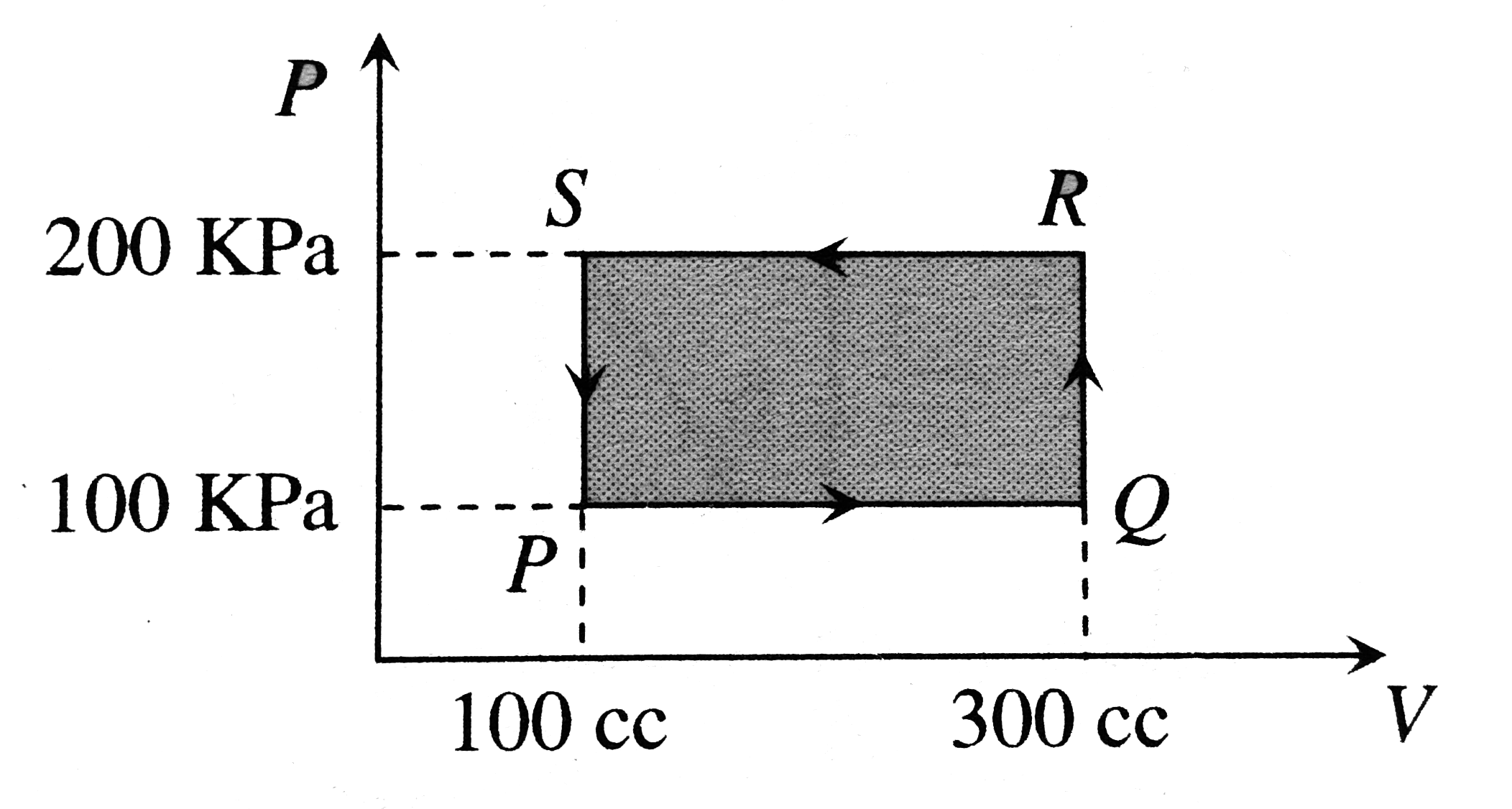In changing the state of a gas adiabatically from an equilibrium state A to another equilibrium state B, an amount of work equal to 22.3J is done on the system. If the gas is taken from State A to B via a process in which the net heat absorbed by the system is 9.35cal., How much is the net work done by the system in the later case? (Take 1cal.=4.9J)
To solve the problem, we will follow these steps:
Step 1: Understand the Adiabatic Process
In the adiabatic process from state A to state B, the work done on the system is given as W=−22.3J. Since it is an adiabatic process, the heat transfer Q is zero.
Step 2: Apply the First Law of Thermodynamics
The First Law of Thermodynamics states:
ΔU=Q+W
For the adiabatic process:
ΔU=0+(−22.3)=−22.3J
This means that the change in internal energy ΔU from state A to state B is −22.3J.
Step 3: Convert Heat from Calories to Joules
In the second process, the heat absorbed by the system is given as Q=9.35cal. We need to convert this to joules using the conversion factor 1cal=4.2J:
Q=9.35cal×4.2Jcal=39.27J
Step 4: Use the First Law of Thermodynamics Again
Now we apply the First Law of Thermodynamics for the second process:
ΔU=Q+W
We already know ΔU=−22.3J from the previous calculation. Plugging in the values:
−22.3=39.27+W
Step 5: Solve for Work Done W
Rearranging the equation to solve for W:
W=−22.3−39.27
W=−61.57J
Step 6: Interpret the Result
Since the work done is negative, it indicates that work is done by the system.
Final Answer
The net work done by the system in the second process is approximately −61.57J.
---
In the adiabatic process from state A to state B, the work done on the system is given as W=−22.3J. Since it is an adiabatic process, the heat transfer Q is zero.
The First Law of Thermodynamics states:
ΔU=Q+W
For the adiabatic process:
ΔU=0+(−22.3)=−22.3J
This means that the change in internal energy ΔU from state A to state B is −22.3J.
In the second process, the heat absorbed by the system is given as Q=9.35cal. We need to convert this to joules using the conversion factor 1cal=4.2J:
Q=9.35cal×4.2Jcal=39.27J
Now we apply the First Law of Thermodynamics for the second process:
ΔU=Q+W
We already know ΔU=−22.3J from the previous calculation. Plugging in the values:
−22.3=39.27+W
Rearranging the equation to solve for W:
W=−22.3−39.27
W=−61.57J
Since the work done is negative, it indicates that work is done by the system.
The net work done by the system in the second process is approximately −61.57J.
Topper's Solved these Questions
- THERMODYNAMICSBOOK - PRADEEPCHAPTER - THERMODYNAMICSEXERCISE - Multiple choice questions
18 Videos
- THERMODYNAMICSBOOK - PRADEEPCHAPTER - THERMODYNAMICSEXERCISE - Problems for practice
54 Videos
- THERMODYNAMICSBOOK - PRADEEPCHAPTER - THERMODYNAMICSEXERCISE - Value based Questions
4 Videos
- SYSTEMS OF PARTICLES AND ROTATIONAL MOTIONBOOK - PRADEEPCHAPTER - SYSTEMS OF PARTICLES AND ROTATIONAL MOTIONEXERCISE - Assertion- Reason Type questions
20 Videos
- WORK, ENERGY AND POWERBOOK - PRADEEPCHAPTER - WORK, ENERGY AND POWEREXERCISE - Assertion-Reason Type Questions
24 Videos
Similar Questions
When the state of a gas adiabatically changed from an equilibrium state A to another equilibrium state B an amount of work done on the stystem is 35 J. If the gas is taken from state A to B via process in which the net heat absorbed by the system is 12 cal, then the net work done by the system is (1 cal = 4.19 J)
View SolutionA thermodynamic system is taken through the cyclic PORSP process (see figure). The net work done by the system is

View Solution
Knowledge Check
In changing the state of a gas adiabatically from an equilibrium state A to another equilibrium state B an amount of work equal to 22.3 J is done on the system.If the gas is taken from state A to B via a process in which the net heat absorbed by the system is 9.35 cal then the net work done by the system in latter case is
(Take 1 case =4.2 J)A15 JB16 JC17 JD18 JWhen the state of a gas adiabatically changed from an equilibrium state A to another equilibrium state B, an amount of work 35 J is done on the system. If the gas is taken from state A to B via process in which the net heat absorbed by the system is 12 cal, then net work done by the system in the latter case is (1 cal = 4.19 J)
A13.2 JB15.4 JC12.6 JD16.8 JA thermodynamic system is taken through the cyclic PQRSP process. The net work done by the system is
 A20JB−20JC400JD−374J
A20JB−20JC400JD−374J
In a process, 701J of heat is absorbed by a system and 394J of work is done by the system. What is the change in internal energy for the process?
View SolutionIn a process, 701 J of heat is absorbed by a system and 394 J of work is done by the system.What is the change in internal energy for the process?
View SolutionAn ideal gas goes from the state i to the state ∫ as shown in .the work done by the gas during the process

View SolutionA system absorbs 300 cal of heat. The work done by the system is 200 cal. ΔU for the above change is
View SolutionIf q is the amount of heat absorbed by the system and W the amount of work done on the system (+ve), the change in the energy of the system is given by:
View Solution
